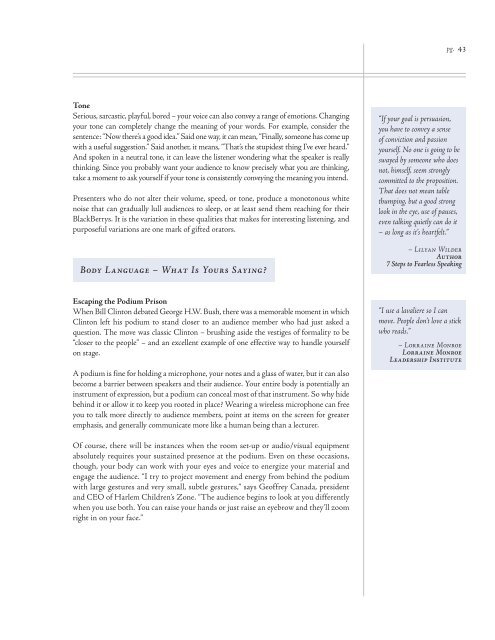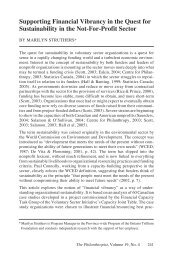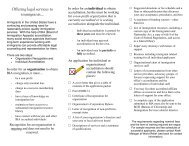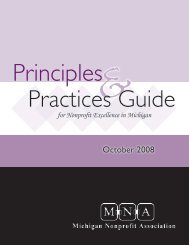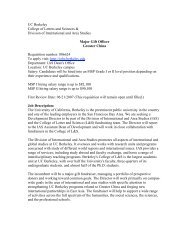Why Bad Presentations Happen to Good Causes - The Goodman ...
Why Bad Presentations Happen to Good Causes - The Goodman ...
Why Bad Presentations Happen to Good Causes - The Goodman ...
You also want an ePaper? Increase the reach of your titles
YUMPU automatically turns print PDFs into web optimized ePapers that Google loves.
Tone<br />
Serious, sarcastic, playful, bored – your voice can also convey a range of emotions. Changing<br />
your <strong>to</strong>ne can completely change the meaning of your words. For example, consider the<br />
sentence: “Now there’s a good idea.” Said one way, it can mean, “Finally, someone has come up<br />
with a useful suggestion.” Said another, it means, “That’s the stupidest thing I’ve ever heard.”<br />
And spoken in a neutral <strong>to</strong>ne, it can leave the listener wondering what the speaker is really<br />
thinking. Since you probably want your audience <strong>to</strong> know precisely what you are thinking,<br />
take a moment <strong>to</strong> ask yourself if your <strong>to</strong>ne is consistently conveying the meaning you intend.<br />
Presenters who do not alter their volume, speed, or <strong>to</strong>ne, produce a mono<strong>to</strong>nous white<br />
noise that can gradually lull audiences <strong>to</strong> sleep, or at least send them reaching for their<br />
BlackBerrys. It is the variation in these qualities that makes for interesting listening, and<br />
purposeful variations are one mark of gifted ora<strong>to</strong>rs.<br />
Body Language – What Is Yours Saying?<br />
Escaping the Podium Prison<br />
When Bill Clin<strong>to</strong>n debated George H.W. Bush, there was a memorable moment in which<br />
Clin<strong>to</strong>n left his podium <strong>to</strong> stand closer <strong>to</strong> an audience member who had just asked a<br />
question. <strong>The</strong> move was classic Clin<strong>to</strong>n – brushing aside the vestiges of formality <strong>to</strong> be<br />
“closer <strong>to</strong> the people” – and an excellent example of one effective way <strong>to</strong> handle yourself<br />
on stage.<br />
A podium is fine for holding a microphone, your notes and a glass of water, but it can also<br />
become a barrier between speakers and their audience. Your entire body is potentially an<br />
instrument of expression, but a podium can conceal most of that instrument. So why hide<br />
behind it or allow it <strong>to</strong> keep you rooted in place? Wearing a wireless microphone can free<br />
you <strong>to</strong> talk more directly <strong>to</strong> audience members, point at items on the screen for greater<br />
emphasis, and generally communicate more like a human being than a lecturer.<br />
Of course, there will be instances when the room set-up or audio/visual equipment<br />
absolutely requires your sustained presence at the podium. Even on these occasions,<br />
though, your body can work with your eyes and voice <strong>to</strong> energize your material and<br />
engage the audience. “I try <strong>to</strong> project movement and energy from behind the podium<br />
with large gestures and very small, subtle gestures,” says Geoffrey Canada, president<br />
and CEO of Harlem Children’s Zone. “<strong>The</strong> audience begins <strong>to</strong> look at you differently<br />
when you use both. You can raise your hands or just raise an eyebrow and they’ll zoom<br />
right in on your face.”<br />
pg. 43<br />
“If your goal is persuasion,<br />
you have <strong>to</strong> convey a sense<br />
of conviction and passion<br />
yourself. No one is going <strong>to</strong> be<br />
swayed by someone who does<br />
not, himself, seem strongly<br />
committed <strong>to</strong> the proposition.<br />
That does not mean table<br />
thumping, but a good strong<br />
look in the eye, use of pauses,<br />
even talking quietly can do it<br />
– as long as it’s heartfelt.”<br />
– Lilyan Wilder<br />
Author<br />
7 Steps <strong>to</strong> Fearless Speaking<br />
“I use a lavaliere so I can<br />
move. People don’t love a stick<br />
who reads.”<br />
– Lorraine Monroe<br />
Lorraine Monroe<br />
Leadership Institute


